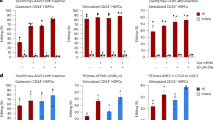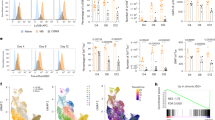Abstract
Human and mouse proliferation-competent, bone marrow or peripheral circulation derived endothelial progenitor-like cells (EPCs) were isolated, expanded and genetically engineered ex vivo to express the beta galactosidase (β-gal), green fluorescence protein or thymidine kinase (TK) genes using retrovirus-mediated gene transfer. Genetically labeled EPCs were transplanted into sublethally irradiated tumor-bearing mice and were found to migrate to and incorporate into the angiogenic vasculature of growing tumors while maintaining transgene expression. Ganciclovir treatment resulted in significant tumor necrosis in animals previously administered TK-expressing EPCs with no systemic toxicity. These results demonstrate the feasibility of using genetically modified EPCs as angiogenesis-selective gene-targeting vectors and the potential of this approach to mediate non-toxic and systemic antitumor responses.
This is a preview of subscription content, access via your institution
Access options
Subscribe to this journal
Receive 12 print issues and online access
$259.00 per year
only $21.58 per issue
Buy this article
- Purchase on Springer Link
- Instant access to full article PDF
Prices may be subject to local taxes which are calculated during checkout




Similar content being viewed by others
References
Folkman J . Tumor angiogenesis: therapeutic implications. N Engl J Med 1971; 285: 1182–1186.
Fan T-PD, Jaggar R, Bicknell R . Controlling the vasculature: angiogenesis, anti-angiogenesis and vascular targeting of gene therapy. TiPS 1995; 16: 57–66.
Holmgren L, O'Reilly MS, Folkman J . Dormancy of micro-metastases: balanced proliferation and apoptosis in the presence of angiogenesis suppression. Nat Med 1995; 2: 149–153.
Folkman J . Angiogenic zip code. Nat Biotechnol 1997; 15: 510.
Asahara T et al. Isolation of putative progenitor endothelial cells for angiogenesis. Science 1997; 275: 964–967.
Asahara T et al. Bone marrow origin of endothelial progenitor cells responsible for postnatal vasculogenesis in physiological and pathological neovascularization. Circ Res 1999; 85: 221–228.
Shi Q et al. Evidence for circulating bone marrow-derived endothelial cells. Blood 1998; 92: 362–367.
Lin Y, Weisdorf DJ, Solovey A, Hebbel RP . Origins of circulating endothelial cells and endothelial outgrowth from blood. J Clin Invest 2000; 105: 71–77.
Peichev M et al. Expression of VEGFR-2 and AC133 by circulating human CD34(+) cells identifies a population of functional endothelial precursors. Blood 2000; 95: 952–958.
Rafii S et al. Characterization of hematopoietic cells arising on the textured surface of left ventricular assist devices. Ann Thorac Surg 1995; 60: 1561–1562.
Gunsilius E et al. Evidence from a leukaemia model for maintenance of vascular endothelium by bone-marrow-derived endothelial cells. Lancet 2000; 355: 1688–1691.
Crosby JR et al. Endothelial cells of hematopoietic origin make a significant contribution to adult blood vessel formation. Circ Res 2000; 87: 728–730.
Gehling UM et al. In vivo differentiation of endothelial cells from AC133-positive progenitor cells. Blood 2000; 95: 3106–3112.
Takahasi T et al. Ischemia- and cytokine-induced mobilization of bone marrow-derived endothelial progenitor cells for neovascularization. Nat Med 1999; 5: 434–438.
de Bont ES et al. Mobilized human CD34+ hematopoietic stem cells enhance tumor growth in a nonobese diabetic/severe combined immunodeficient mouse model of human non-Hodgkin's lymphoma. Cancer Res 2001; 61: 7654–7659.
Kalka C et al. Transplantation of ex vivo expanded endothelial progenitor cells for therapeutic neovascularization. Proc Natl Acad Sci USA 2000; 97: 3422–3427.
Kawamoto A et al. Therapeutic potential of ex vivo expanded endothelial progenitor cells for myocardial ischemia. Circulation 2001; 103: 634–637.
Lyden D et al. Impaired recruitment of bone-marrow-derived endothelial and hematopoietic precursor cells blocks tumor angiogenesis and growth. Nat Med 2001; 7: 1194–1201.
Bevilacqua MP, Stengelin S, Gimbrone Jr MA, Seed B . Endothelial leukocyte adhesion molecule 1: an inducible receptor for neutrophils related to complement regulatory proteins and lectins. Science 1989; 243: 1160–1165.
Bevilacqua MP . Endothelial—leukocyte adhesion molecules. Ann Rev Immunol 1993; 11: 767–804.
Senger DR et al. Stimulation of endothelial cell migration by vascular permeability factor/vascular endothelial growth factor through cooperative mechanisms involving the αvβ3 integrin, osteopontin, and thrombin. Am J Pathol 1996; 149: 293–305.
Senger DR . Molecular framework for angiogenesis. Am J Pathol 1996; 149: 1–7.
Harel J, Rassart E, Jolicoeur P . Cell cycle dependence of synthesis of unintegrated viral DNA in mouse cells newly infected with murine leukemia virus. Virology 1981; 110: 202–207.
Miller DG, Adam MA, Miller DA . Gene transfer by retrovirus vectors occurs only in cells that are actively replicating at the time of infection. Mol Cell Biol 1990; 10: 4239–4242.
Nolta JA, Kohn DB . Comparison of the effects of growth factors on retroviral vector-mediated gene transfer and the proliferative status of human hematopoietic progenitor cells. Hum Gene Ther 1990; 1: 257–268.
Williams DA . Expression of introduced genetic sequences in hematopoietic cells following retroviral-mediated gene transfer. Hum Gene Ther 1990; 1: 229–239.
Nolta JA, Smogorzewska EM, Kohn DB . Analysis of optimal conditions for retroviral-mediated transduction of primitive human hematopoietic cells. Blood 1995; 86: 101–110.
Emerson SG . Ex vivo expansion of hematopoietic precursors, progenitors, and stem cells: the next generation of cellular therapeutics. Blood 1996; 87: 3082–3088.
Rafii S . Circulating endothelial precursors: mystery, reality, and promise. J Clin Invest 2000; 105: 17–19.
Hanenberg H et al. Colocalization of retrovirus and target cells on specific fibronectin fragments increases genetic transduction of mammalian cells. Nat Med 1996; 2: 876–882.
Hanenberg H et al. Optimization of fibronectin-assisted retroviral gene transfer into human CD34+ hematopoietic cells. Hum Gene Ther 1997; 8: 2193–2206.
Hanahan D, Weinberg RA . The hallmarks of Cancer. Cell 2000; 100: 57–70.
Choi K et al. A common precursor for hematopoietic and endothelial cells. Development 1998; 125: 725–732.
Gomez-Navarro J et al. Genetically modified CD34+ cells as cellular vehicles for gene delivery into areas of angiogenesis in a rhesus model. Gene Therapy 2000; 7: 43–52.
Freeman SM et al. The bystander effect: tumor regression when a fraction of the tumor mass is genetically modified. Cancer Res 1993; 53: 5274–5283.
Tanaka T, Manoma Y, Wen PY, Kufe DW, Fine HA . Viral-vector mediated transduction of a modified platelet factor 4 cDNA inhibits angiogenesis and tumor growth. Nature Medicine 1997; 3: 381–387.
Author information
Authors and Affiliations
Rights and permissions
About this article
Cite this article
Ferrari, N., Glod, J., Lee, J. et al. Bone marrow-derived, endothelial progenitor-like cells as angiogenesis-selective gene-targeting vectors. Gene Ther 10, 647–656 (2003). https://doi.org/10.1038/sj.gt.3301883
Received:
Accepted:
Published:
Issue Date:
DOI: https://doi.org/10.1038/sj.gt.3301883
Keywords
This article is cited by
-
Endothelial progenitor cells overexpressing platelet derived growth factor-D facilitate deep vein thrombosis resolution
Journal of Thrombosis and Thrombolysis (2022)
-
Magnetic resonance imaging targeting of intracranial glioma xenografts by Resovist-labeled endothelial progenitor cells
Journal of Neuro-Oncology (2011)
-
Blood outgrowth endothelial cell-based systemic delivery of antiangiogenic gene therapy for solid tumors
Cancer Gene Therapy (2010)
-
AC133+ progenitor cells as gene delivery vehicle and cellular probe in subcutaneous tumor models: a preliminary study
BMC Biotechnology (2009)
-
Endothelial progenitor cells and their potential clinical implication in cardiovascular disorders
Journal of Endocrinological Investigation (2009)



